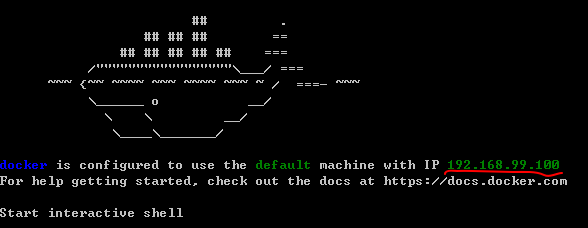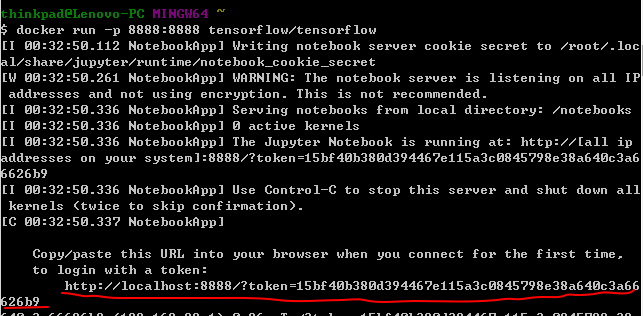首先,何謂tensor?即高維向量,例如矩陣是二維,tensor是更廣義意義上的n維向量(有type+shape)
TensorFlow執行過程為定義圖,其中定義子節點,計算時只計算所需節點所依賴的節點,是一種高效且適應大規模的數據計算,方便分布式設計,對于復雜神經網絡的計算,可將其拆開到其他核中同時計算。
Theano——torch———caffe(尤其是圖像處理)——deeplearning5j——H20——MXNet,TensorFlow
運行環境
下載docker
打開docker quickstart terminal

標紅地方顯示該docker虛擬機IP地址(即之后的localhost)
docker tensorflow/tensorflow//自動找到TensorFlow容器并下載
docker images//瀏覽當前容器
docker run -p 8888:8888 tensorflow/tensorflow//在8888端口運行

會出現一個token,復制該鏈接并替換掉localhost,既可以打開TensorFlow的一個編寫器,jupyter
大體雛形#python導入importtensorflowastf#定義變量(節點)x = tf.Variable(3, name="x")y = tf.Variable(4, name="y")f = x*x*y + y +2#定義sessionsess = tf.Session()#為已經定義的節點賦值sess.run(x.initializer)sess.run(y.initializer)#運行sessionresult = sess.run(f)print(result) #42#釋放空間sess.close
還有一個更簡潔的一種定義并運行session方法
# a better waywith tf.Session()assess: x.initializer.run() y.initializer.run()#即evaluate,求解f的值 result = f.eval()
初始化的兩行也可以寫作
init = tf.global_variables_initializer()
init.run()
而session可以改作sess=tf.InteractiveSession()運行起來更方便
init =tf.global_variables_initializer()sess =tf.InteractiveSession()init.run()result =f.eval()print(result)
因而TensorFlow的代碼分為兩部分,定義部分和執行部分
TensorFlow是一個圖的操作,有自動缺省的默認圖和你自己定義的圖
#系統默認缺省的圖>>> x1 = tf.Variable(1)>>> x1.graph is tf.get_default_graph()True#自定義的圖>>> graph = tf.Graph()>>> with graph.as_default():x2 = tf.Variable(2)>>> x2.graph is graphTrue>>> x2.graph is tf.get_default_graph()False節點的生命周期
第二種方法可以找出公共部分,避免x被計算2次。
運行結束后所有節點的值都被清空,如果沒有單獨保存,還需重新run一遍。
w=tf.constant(3)x=w+2y=x+5z=x*3withtf.Session()assess: print(y.eval()) #10 print(z.eval()) #15withtf.Session()assess: y_val, z_val = sess.run([y,z]) print(y_val) #10 print(z_val) #15Linear Regression with TensorFlow
(線性回歸上的應用)
y = wx+b = wx'//這里x'是相較于x多了一維全是1的向量
這里引用California housing的數據
TensorFlow上向量是列向量,需要reshape(-1,1)即轉置成列向量
使用normal equation方法求解
import numpyasnpfrom sklearn.datasets import fetch_california_housinghousing = fetch_california_housing()#獲得數據維度,矩陣的行列長度m, n = housing.data.shape#np.c_是連接的含義,加了一個全為1的維度housing_data_plus_bias = np.c_[np.ones((m,1)), housing.data]#數據量并不大,可以直接用常量節點裝載進來,但是之后海量數據無法使用(會用minbatch的方式導入數據)X=tf.constant(housing_data_plus_bias, dtype=tf.float32, name="X")#轉置成列向量y=tf.constant(housing.target.reshape(-1,1), dtype=tf.float32, name="y")XT =tf.transpose(X)#使用normalequation的方法求解theta,之前線性模型中有提及theta =tf.matmul(tf.matmul(tf.matrix_inverse(tf.matmul(XT,X)), XT),y)#求出權重withtf.Session()assess: theta_value = theta.eval()
如果是原本的方法,可能更直接些。但由于使用底層的庫不同,它們計算出來的值不完全相同。
#使用numpyX = housing_data_plus_biasy = housing.target.reshape(-1,1)theta_numpy = np.linalg.inv(X.T.dot(X)).dot(X.T).dot(y)#使用sklearnfromsklearn.linear_modelimportLinearRegressionlin_reg = LinearRegression()lin_reg.fit(housing.data, housing.target.reshape(-1,1))
這里不禁感到疑惑,為什么TensorFlow感覺變復雜了呢?其實,這不過因為這里數據規模較小,進行大規模的計算時,TensorFlow的自動優化所發揮的效果,是十分厲害的。
使用gradient descent(梯度下降)方法求解
#使用gradient時需要scale一下from sklearn.preprocessing import StandardScalerscaler = StandardScaler()scaled_housing_data = scaler.fit_transform(housing.data)scaled_housing_data_plus_bias = np.c_[np.ones((m,1)), scaled_housing_data]#迭代1000次n_epochs =1000learning_rate =0.01#由于使用gradient,寫入x的值需要scale一下X=tf.constant(scaled_housing_data_plus_bias, dtype=tf.float32, name="X")y=tf.constant(housing.target.reshape(-1,1), dtype=tf.float32, name="y")#使用gradient需要有一個初值theta =tf.Variable(tf.random_uniform([n +1,1], -1.0,1.0), name="theta")#當前預測的y,x是m*(n+1),theta是(n+1)*1,剛好是y的維度y_pred =tf.matmul(X, theta, name="predictions")#整體誤差error = y_pred -y#TensorFlow求解均值功能強大,可以指定維數,也可以像下面方法求整體的mse =tf.reduce_mean(tf.square(error), name="mse")#暫時自己寫出訓練過程,實際可以采用TensorFlow自帶的功能更強大的自動求解autodiff方法gradients =2/m*tf.matmul(tf.transpose(X), error)training_op =tf.assign(theta, theta - learning_rate * gradients)#初始化并開始求解init =tf.global_variables_initializer()withtf.Session()assess: sess.run(init) forepoch inrange(n_epochs): #每運行100次打印一下當前平均誤差 ifepoch %100==0: print("Epoch", epoch,"MSE =", mse.eval()) sess.run(training_op) best_theta = theta.eval()
上述代碼中的autodiff如下,可以自動求出gradient
gradients= tf.gradients(mse, [theta])[0]
使用Optimizer
上述的整個梯度下降和迭代方法,都封裝了在如下方法中
optimizer= tf.train.GradientDescentOptimizer(learning_rate=learning_rate)
training_op= optimizer.minimize(mse)
這樣的optimizer還有很多
例如帶沖量的optimizer = tf.train.MomentumOptimizer(learning_rate=learning_rate,momentum=0.9)
Feeding data to training algorithm
當數據量達到幾G,幾十G時,使用constant直接導入數據顯然是不現實的,因而我們用placeholder做一個占位符
(一般行都是none,即數據量是任意的)
真正運行,run的時候再feed數據。可以不斷使用新的數據。
>>>A = tf.placeholder(tf.float32, shape=(None,3))>>>B = A +5>>>withtf.Session()assess:...B_val_1 = B.eval(feed_dict={A: [[1,2,3]]})...B_val_2 = B.eval(feed_dict={A: [[4,5,6], [7,8,9]]})...>>>print(B_val_1)[[6.7.8.]]>>>print(B_val_2)[[9.10.11.][12.13.14.]]
這樣,就可以通過定義min_batch來分批次隨機抽取指定數量的數據,即便是幾T的數據也可以抽取。
batch_size =100n_batches = int(np.ceil(m / batch_size))#有放回的隨機抽取數據deffetch_batch(epoch, batch_index, batch_size): #定義一個隨機種子 np.random.seed(epoch * n_batches + batch_index) # not shown in the book indices = np.random.randint(m, size=batch_size) # not shown X_batch = scaled_housing_data_plus_bias[indices]# not shown y_batch = housing.target.reshape(-1,1)[indices]# not shown returnX_batch, y_batch#開始運行withtf.Session()assess: sess.run(init)#每次都抽取新的數據做訓練 forepochinrange(n_epochs): forbatch_indexinrange(n_batches): X_batch, y_batch = fetch_batch(epoch, batch_index, batch_size) sess.run(training_op, feed_dict={X: X_batch, y: y_batch})#最終結果 best_theta = theta.eval()
Saving and Restoring models(保存模型)
有時候,運行幾天的模型可能因故暫時無法繼續跑下去,因而需要暫時保持已訓練好的部分模型到硬盤上。
init =tf.global_variables_initializer()saver =tf.train.Saver()#保存模型withtf.Session()assess: sess.run(init) forepoch inrange(n_epochs): ifepoch %100==0: #print("Epoch", epoch,"MSE =", mse.eval()) save_path = saver.save(sess,"/tmp/my_model.ckpt") sess.run(training_op) best_theta = theta.eval() save_path = saver.save(sess,"/tmp/my_model_final.ckpt")#恢復模型withtf.Session()assess: saver.restore(sess,"/tmp/my_model_final.ckpt") best_theta_restored = theta.eval()關于TensorBoard
眾所周知,神經網絡和機器學習大多是黑盒模型,讓人有點忐忑。TensorBoard所起的功能就是將這個黑盒稍微變白一些~
啟用tensorboard
輸入docker ps查看當前容器id

進入容器

使用tensorboard --log-dir=tf_logs命令打開已經存入的tf_logs文件,其生成代碼如下所示
from datetime import datetimenow = datetime.utcnow().strftime("%Y%m%d%H%M%S")root_logdir ="tf_logs"logdir ="{}/run-{}/".format(root_logdir, now)...mse_summary =tf.summary.scalar('MSE', mse)file_writer =tf.summary.FileWriter(logdir,tf.get_default_graph())...ifbatch_index %10==0: summary_str = mse_summary.eval(feed_dict={X: X_batch,y: y_batch}) step = epoch * n_batches + batch_index file_writer.add_summary(summary_str, step)
-
機器學習
+關注
關注
66文章
8496瀏覽量
134218 -
tensorflow
+關注
關注
13文章
330瀏覽量
61067
原文標題:【機器學習】TensorFlow學習(一)
文章出處:【微信號:AI_shequ,微信公眾號:人工智能愛好者社區】歡迎添加關注!文章轉載請注明出處。
發布評論請先 登錄
干貨!教你怎么搭建TensorFlow深度學習開發環境!
TensorFlow運行時無法加載本機
深度學習框架TensorFlow&TensorFlow-GPU詳解
TensorFlow安裝和下載(超詳細)
第一個TensorFlow程序(hello world)詳解
詳解MCU的運行過程
淺析為Windows on Arm設置Tensorflow的步驟
在Ubuntu 18.04 for Arm上運行的TensorFlow和PyTorch的Docker映像
TensorFlow是什么?如何啟動并運行TensorFlow?
如何基于 ES6 的 JavaScript 進行 TensorFlow.js 的開發
在MaaXBoard RT上運行幾乎任何TensorFlow模型



















評論